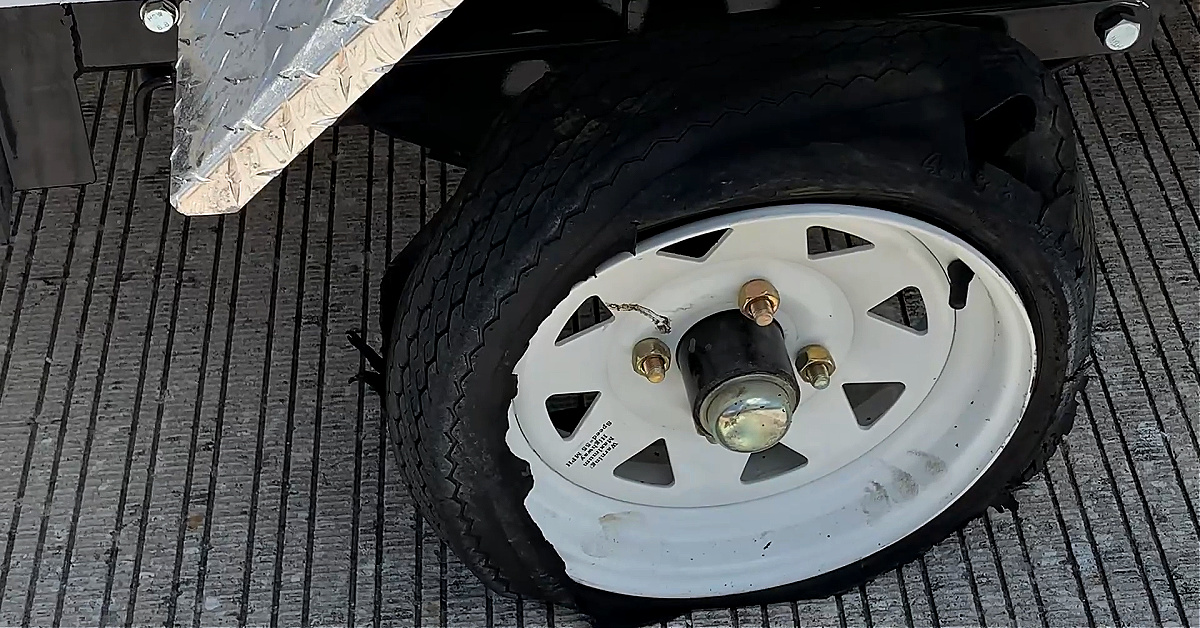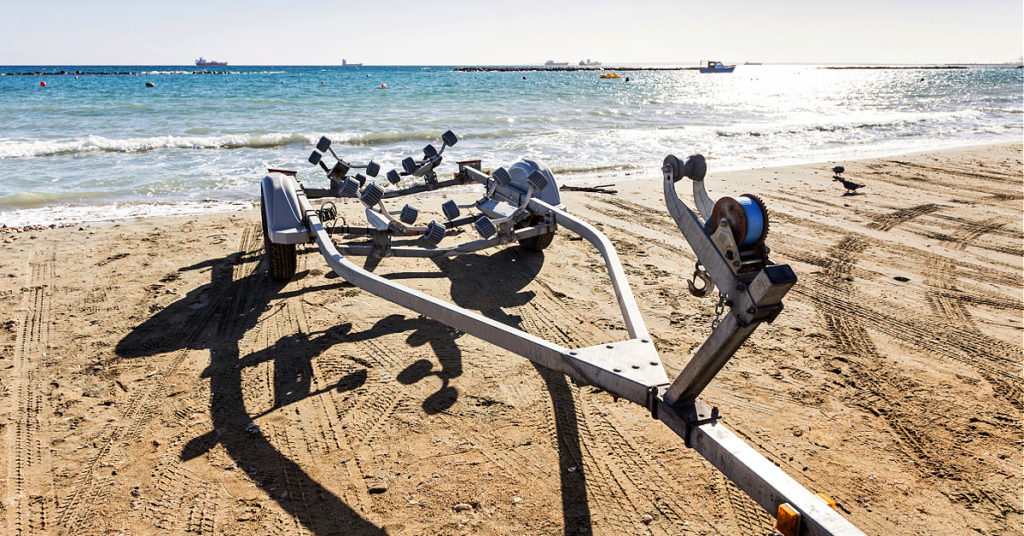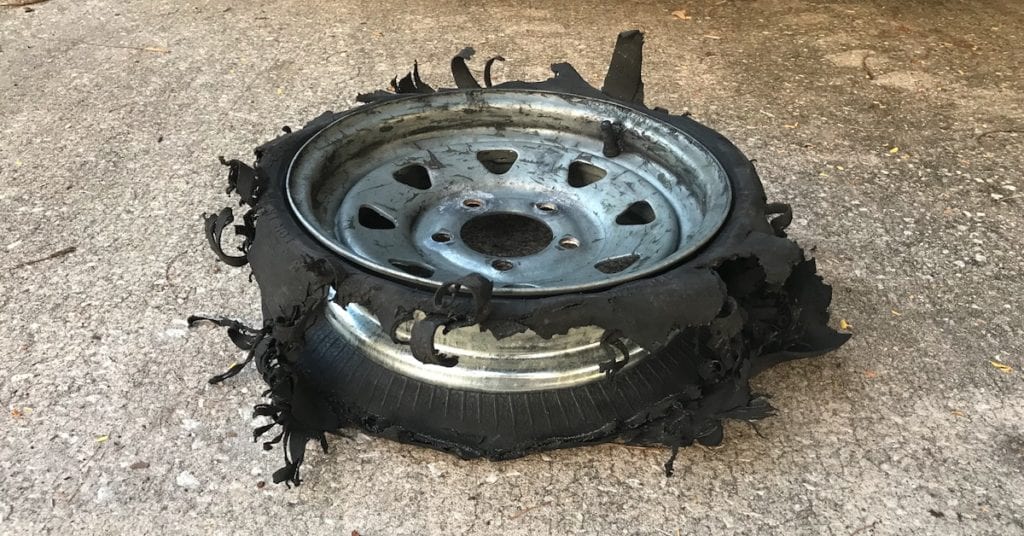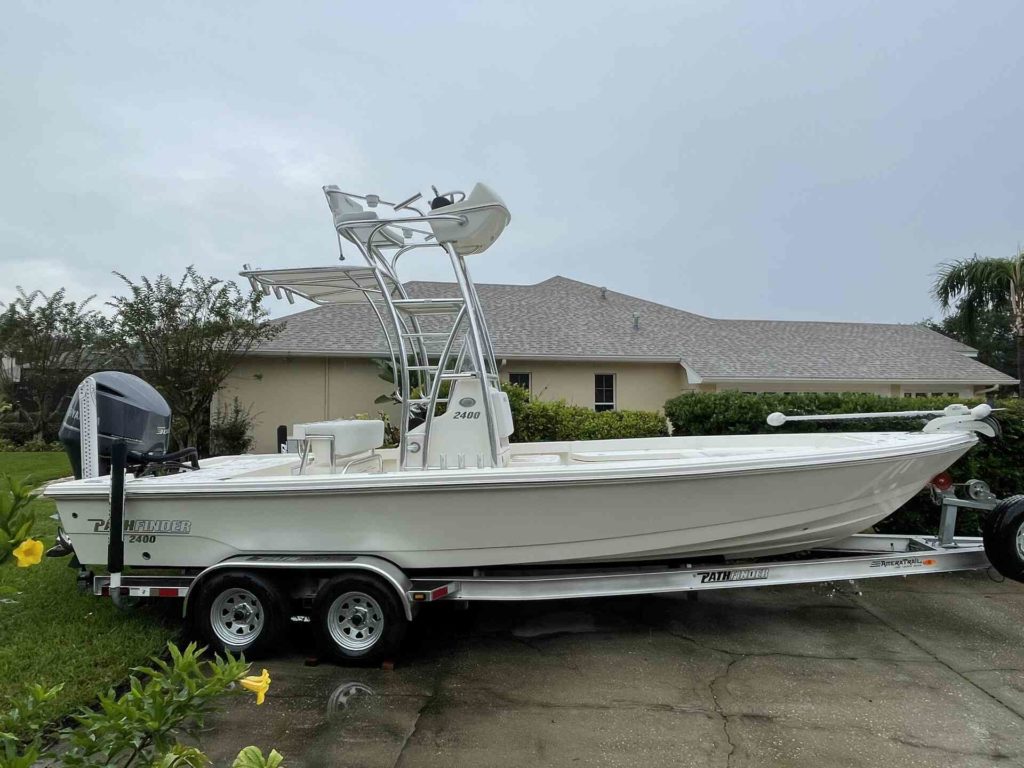Boat Trailer Tires 101: The TRUTH About Trailer Tires
- By: Pat Ogletree
- on

Do you know everything about Boat Trailer Tires 101?
When is the right time to change your trailer tires to avoid a possible mishap or incident?
If you want to learn everything there is about trailer tires, then check this out!
Learn more below!!
Boat Trailer Tires 101

Lots of boat owners will be able to tell you every single detail about their boat, but they may know little to nothing about their trailer and trailer tires.
Differences Between Tire Types
There are differences between car tires, truck tires, and trailer tires.
You cannot try to put a car tire in place of a trailer tire on a trailer.
Car tires are designed to be smooth and long-lasting to withstand harsh weather conditions.
They are further designed for standard vehicles like SUVs and sedans.
Car tires are not durable enough to have on your trailer.
Moreover, light truck tires are for 3/4 ton and full ton pick-up trucks.
They are slightly more durable than passenger car tires, however, they are not designed to be used on a trailer.
Trailer tires are designed to withstand the abuse and neglect they commonly go through when in use.
There is a tendency to hit more curbs and potholes when you are driving a trailer around rather than just a vehicle itself.
The nylon that is used to form the tire as well is tougher and stronger than that used in normal passenger cars.
Additionally, passenger car and truck tires are engineered to fit vehicles with steering wheels that are driven around.
Trailer tires do not take steering into account and have different grooves in the tires to prevent swaying back and forth.
Reading The Side Wall Of The Tire
There are certain markings and indications along the outside wall of the tire that ensure it is actually a trailer tire.
Some trailer tires will have numbers and letters combined on the walls to represent details and give you more information about the specific kind of tire it is.
For example, some may begin with an “ST” which stands for ‘Special Trailer Tire’.
This means the tire has been specifically designed for trailer use.
The number continues after the “ST” with the width of the tire followed by the height of the sidewall as well as the rim diameter.
This is important information because you need to make sure you have the same exact specifications when you go to get a new tire if your existing one needs a replacement.
Also, the number along the side wall will either contain an ‘R’ or a ‘D’.
‘R’ indicates it is a radial tire while ‘D’ labels the tire as a bias-ply tire.
Radial tires are typically better quality tires.
Furthermore, there are numbers along the rim to indicate the total amount of air pressure the tire can take.
Speed Ratings
Trailer tires have their own individual speed ratings that are extremely different from that of cars.
Trailer tire speed ratings are much lower than traditional car tires.
They can range from as low as 56-mph and as high as 87-mph.
Standard car tires begin around 112-mph and can go above 186-mph.
You need to be careful and select a tire that fulfills the needs of your drive.
If you are not traveling far with your trailer, you can get away with a lower-speed tire.
On the other hand, if you need to travel on the highway at high speeds, choose the tire that can support quicker speeds.
Tire Placard
Every trailer that is manufactured has a tire placard on it to help you understand what tires fit the trailer best.
Any time you go to replace or change out any of the tires on your trailer, be sure to have a look at the placard to confirm.
This is especially relevant when you are either buying or using a trailer that was previously owned.
The previous owner may have used different tires and ignored the guidelines on the placard.
The tire placard will let you know what tires are supposed to be on the trailer.
Replacing Trailer Tires
As mentioned before, there are two types of tires for trailers: radial tires and bias-ply tires.
Bias-ply tires are typically entry-level, low-cost trailer tires.
Radial construction tires are always going to be the better quality tire.
To add on, radial tires are built to tackle driving at higher speeds.
Other than a puncture, the biggest adversary to tires is heat.
When you drive fast or drive using an underinflated tire, a lot of heat is generated within the tire.
The heat fails to dissipate and in turn causes lots of tire issues.
You need to make sure your tires are properly inflated, meet the load index of the trailer, and you are not driving too fast on them.
Air Pressure
With any trailer tire, you always want it to run at maximum air pressure.
The reasons for this being the tires will dissipate heat better, the tire will handle better, and it will be able to tackle the load easier.
Anything less than maximum air pressure and the tire could create more heat than it is prepared for and cause major issues.
Most boats will fall into the C-load range tires category at 50 PSI.
Read the side of your tire to verify the proper pressure the air should be set to.
Visual Tire Inspections

It is in your best interest to check the tire’s air pressure before heading out each time.
You never know if you picked up a nail or there is a malfunction with a tire from your last trip.
You should inspect your trailer tires at the very least once a month.
There is no way to truly know if anything is wrong with the tire unless you take a look at them.
Side Of The Tire
The first thing you should do when inspecting a tire is check the date the tire was manufactured on the side of the tire.
There will be 4 numbers grouped together that indicate the date the tire was made.
The first two numbers are the week of the year in which the tire was assembled and then the last two are the year the tire was built.
Next, you need to inspect the bead area of the tire.
This is truly the anchor of your tire because it keeps it snugly attached to the rim.
It takes the brunt of a lot of the abuse tires must handle in terms of the heat and other outstanding conditions.
Start in one area of the tire and work your way around looking for any cracks or marks to indicate damage to the tire.
As you finish checking the entirety of the bead area around the rim, continue to work your way outwards and inspect the rest of the tire.
We are looking for weather cracking and odd things that do not look correct.
Shoulder & Tread
After the bead area, you need to check the shoulder and tread areas of the tire.
The old adage in terms of tire tread is “Lincoln’s Head” and once you see the penny peeking out of the tread, it is time to change out the tire.
In reality, that is not the best way to determine that.
New tires have an indicator built into the tread of the tires to let you know when it is time to change it out.
Once that bump is exposed, it is time to change the tire.
Some tires will have a “TWI” which is the Tread-Wear Indicator.
If you follow that line around the tire, you will see a raised area that if exposed indicates a tire change is needed.
Moreover, it is best to inspect for nails, punctures, and issues with the tire along the tread.
Be sure to not immediately remove any nails you see right away.
It is best to take the tire to a tire shop and have them look at it first.
Lastly, gently slide your hand along the tire to feel for any irregular wear.
Irregular wear can let you know if there is something out of the ordinary going on within the tires and mechanics.
It is also important to get under your trailer to inspect the inside of the tire.
Be sure to have a flashlight handy and repeat the same process on the inside as we did on the outside of the tire.
It is also in your favor to check the suspension on the trailer while you are inspecting the tire.
Boat Trailer Tires 101


Conclusion

Trailer tires are extremely important if you are transporting a boat to and from the water on highways or even just in town.
Do not fall into the trap of ignoring and neglecting your trailer tires to the point where something goes wrong and it could have been prevented with more attentiveness!!
Be sure to pay attention to the tire details and replace your tires with the exact same kind as said on the tire placard!
Do you have any more questions about Boat Trailer Tires 101?
Let me know down in the comments!
And if you know someone who wants to learn more about Boat Trailer Tires 101, please TAG or SHARE this with them!
P.S. Want access to our best fishing spots and tips, plus discounts to our online tackle store? Click here to join us in the Insider Club!
Related Articles:
Related categories:
STOP WASTING TIME ON THE WATER!
Do what the “SMART ANGLERS” are doing and join the Insider Club.
Here’s what you’ll receive today when you join:
- Weekly fishing reports and TRENDS revealing exactly where you should fish every trip
- Weekly “spot dissection” videos that walk you through all the best spots in your area
- Exclusive fishing tips from the PROS you can’t find anywhere else
- Everything you need to start catching fish more consistently (regardless if you fish out of a boat, kayak, or land).










need to boat trailer tires that are p175x70r13. Can’t seem to find them. Does anyone have an idea where I could look. Live in the state of Indiana. Thank you
Replace 2-4 trailer tires a year. Changed to light truck tires and 4 years not even a flat. California pot holes and all. And we tow the boat 4-6hrs one way multiple times a year and log 8-15,000 miles a year with the boat behind us.
Yes exactly opposite of what this site recommended and I agree with you 💯 the article say suv and truck tire are to durable and speed rated much higher that’s why light truck tires are better on your trailer
Excellent instruction Pat, thank you.
Ford did a study on tires a few years ago, and recommended that they be replaced after 7 years, regardless of how they look. This would be especially true in Florida. I found out the hard way, last year, when 2 of my perfect looking tires blew out within 20 miles. It was a wonderful day. They were kept properly inflated and routinely inspected, but they deteriorated inside, which was evident at the tire shop. Parking in the shade or covering the tires would be helpful for reducing UV damage.
This is one of the best articles on Salt Strong and, as usual, Pat has the ability to convey information logically and succinctly. I had always checked for things such as tread depth, wear patterns, cracks and inflation preassure. but there are other items you pointed out that I didn’t know because I made assumptions attributable to passenger and truck tires. My trailer / boat where preowned when I bought it. Since I have had it, it’s been maintained in the garage away from the sun. I checked the manufacturer’s date and it’s way back in 2010. So by this measure, it appears like it’s high time to replace. Question I have is, will most tire installers take care of installing trailer tires? Even if I bring my own? Also, would it be wise to replace the spare as well though it looks like it hasn’t touched asphalt in it’s life? Thank you again Pat
Thank you so much for the kind words Luis!
It definitely sounds like you due for a replacement.
With how popular online buying is now, most tire dealers will install tires that you bring in to them although they might charge you more for that service. I would call ahead of time.
As far as the spare goes, definitely change that too. If you had to use it in an emergency you wouldn’t want that to fail on you either.
I learned the hard way about trailer tires.
I tow a travel trailer, rather than a boat, but the same rules apply, lol.
I was buying the cheapest tires I could find, and having to replace them every 2 years.
My worst trip, less than 200 miles round trip, I blew 3 of the 4 tires on the trailer, including the spare. On a Sunday. I had to park the trailer, set the jacks, and call around to find someone open on a Sunday with trailer tires in stock. Oh, and willing to stay open long enough to put them on the rims. I got lucky, and found someone to take care of it.
Move forward to a new, larger, HEAVIER travel trailer. This time I did my research, and went with a national name branded tire (much better quality), and slowed my a$$ DOWN. Most trailer tires I can find are speed rated at 65 mph. Yeah, my truck can pull it just fine at 75, but that don’t mean I should! A 200 mile trip may take 30 minutes longer, but that’s 30 minutes you won’t spend changing tires. I currently have 3 years use on the better tires, and they’re still going strong.
Oh, piece of advice. If you have to replace a tire due to a blowout, replace the rest of them, too. They took the same abuse…
Perfectly said Kirk! I’ve been in the tire industry for decades and I can assure you you get what you pay for in all but very few cases.
I am ready to replace my trailer tires myself and I plan on balancing with balancing beads ( equal or Dyna beads ) is there an issue using this method as to regular spin balance
I would definitely recommend using a regular spin balance. The beads are usually something you would use in larger tires like semi trucks when it requires a lot of weight to be used. In a smaller tire like a trailer there’s no need to add things and over complicate it.
Vert Good article Pat. Most people don’t give tires a 2nd thought. I have been trailering for over 50 years & can tell you some horror stories about trailer tire blowouts, but I’ll save that for another time. In some of the questions & answers I noticed that balancing was brought up & I believe it is just as important as tire air pressure to keep the tires from over heating. Something that was not noted is why trailer tires typically come without warranty? The only company that has a warranty on trailer tires to my knowledge is Kenda. I have used them for years but like all trailer tires have plenty of issues, especially at highway speeds. Something that I may have missed is where to find the speed recommendation on trailer tires? I typically use a D rated radial on my tandem axle Road King trailer but have had issues with blow outs running at 70-75 mph. The manufacture has not able to figure it out.
Thanks, Capt. Bill
Thanks Jeanne!
Actually most trailer tires do come with a warranty. Although not a mileage warranty because that’s too hard to track with a trailer but they do come with a manufacturer warranty against defects in material and workmanship. In fact, it’s a pretty good indicator of where they are in the quality line up, being entry level, mid line and premium. If a tire has a two year or less warranty they will usually be in the entry level category. Three to four years is usually a mid level and five years will be a premium tire. Now this is just a loose guideline but I’ve found it to be fairly accurate. Hope this helps.
I am a tyre obsessive.
A student of LK Setright and a past performance tyre tester for Michelin.
Think endless laps of Silverstone.
Trailers, from family camping sizes to Youth Trip trailers with a dozen canoes and gear, off to the Ardeche.
In France, trailers above 500kg require regular, probably annual, testing certificates.
Really, the best system.
My 750kg UK built trailer was plated for initial sale on the French market as a 500kg.
We live in somewhere impossible for automomous vehicles.
Roads, 10ft wide, hidden drainage ditches, protruding logs and rocks and everywhere you go tractors or the Ubiquitous blue Rugger towing a trailer carrying sheep, pigs or calves.
Meet any of these, you back, maybe a couple of hundred yards. Drive 4 x 4 of course because of the mud.
Tyre specifics.
Nearly everything covered but.
Auto tyres are shipped partially cured. This promotes very long warehouse shelf life.
The first 500 or so road miles, completes the curing process.
You do keep new tyres down to 50mph for the first 500miles don’t you?
Also, why wet grip will improve over 2,000miles.
Once cured, they have about 5years before perishing sets it. Protect them from UV or it will be less.
So, replace trailer tyres every five years, regardless of mileage / wear.
Sea water will not affect tyres much but will totally trash the trailer.
Wash thoroughly in fresh water, every use.
In the UK each voluntary RNLI station employs a full time engineer.
If the station has ribs (invented by Atlantic College for the RLNI) most of the work goes on the launching retrieval systems. Sometimes these are 70% submersible.
Seasonally, dismount your tyres to make good corrosion incursions at the wheel rims.
Aspire to maintaining your gear as well as the Japanese.
The tech in tyres compares to a Swiss Watch or a Nikon Film camera.
They deserve respect. Your safety depends on them.
Rgds.
Great input as usual Malcolm!
You’re correct on the curing process of tires, it takes a few heat cycles to get that compound exactly they way the manufacturers designed it to be. Also to burn off the mold release compounds too.
Europe has much more stringent standards than we do here in the US. I wish we would adopt some of those here but to address the statement of keeping your new tires under 50 mph for the first 500 miles, it’s closer to, I’ll try to keep it under 80 once I leave the parking lot. That subject is not even mentioned over here.
Yes, most people have no idea how precise a premium tire manufacturer is when it comes to all aspects of the tire. From design to even the shipping process of getting them to the retailers. A fine Swiss watch is a great comparison.
Thanks as always
Pat
When they started making you buy trailer tires for trailers that took away their liability I never had a flat before that and now I cannot count how many blowouts we have had and yes I check my tires when you see a so called 6 ply tire blown out and see how they are built you see junk I now buy the heaviest ply possible
Always check the length of the warranty on the tires. It’s typically a tell of the quality of the tire. Two years or less is an entry level tire, 3 or 4 years years is typically a mid level and five years is going to be a premium tire. If it doesn’t have at least a two year warranty, I would stay away from it.